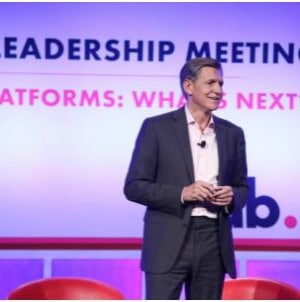
That’s something radio executives will be happy to hear, because it’s coming from a major advertiser. Procter and Gamble’s Chief Brand Officer Marc Pritchard said it on Sunday. Radio executives have long been concerned that advertisers were throwing buckets of money at all forms of digital and social, mostly because it’s the shiny new thing, not necessarily because it’s increasing business. And that’s been a big challenge for radio in recent years. Pritchard urged the rest of the ad industry to follow P&G’s lead. “It’s time to grow up. It’s time for action.”
At the annual IAB Leadership Meeting on Sunday, Pritchard said P&G will accept only the MRC-validated viewability standard for media transacting. P&G expects all of its agencies, media suppliers, and platforms to adopt the standard in 2017. Pritchard also emphasized the importance of transparency in the media supply chain, eliminating fraud, and putting creativity first.
Triton Digital President of Market Development John Rosso told Radio Ink Pritchard is right on the mark. “An independent third party validation of audiences and ad exposure is critical to the success of both media and marketers. One of the things that separates online audio from most other types of advertising is the accuracy of the planning metrics, and the almost complete lack of fraud and viewability problems in the medium.”
AdAge reports that P&G will conduct a review of all media-agency contracts, after the company found a surprise in its dealings with at least one agency, plus requirements that everyone use industry-standard viewability metrics, fraud protection, and third-party verification. Pritchard said the company has vowed to no longer pay for any digital media, ad tech companies, agencies, or other suppliers for services that don’t comply with its new rules.






It will be profitable for everyone when, so-called, “creative” is also held to objective standards of changing consumer behavior, results generation and transparency and not just “passion” and hand-waving.
While I am sure Mickey is relating real-life and all-too-common experiences, is it not still incumbent on radio to massage that along? Are reps able to make the distinctions and press those on their clients? We are, after all, still doomed by our own dogma.
Further, I’m not such an idealist as to think that creative “Creative” is the only way to go, especially since the majority of ads are content-driven and of the direct response category.
Even those ads can be written to be more listenable and more influential.
Very few would even catch on. There is a form of, how we say in my country, “guerilla copy writing”.
Creativity is largely driven by the client. You can beat your head against a wall with clients to get them to try new creative approaches, but at the end of the day if the client only want a dull, cliche filled ad, that’s what we’ll broadcast for them.
Radio is a supremely creative medium, but it’s up to the client on how to use it.
While an interesting turn of events and perhaps a worthwhile (to radio) trend, the article also insists on “creativity” as a major component.
Is radio prepared to act on that advice?
Hardly.